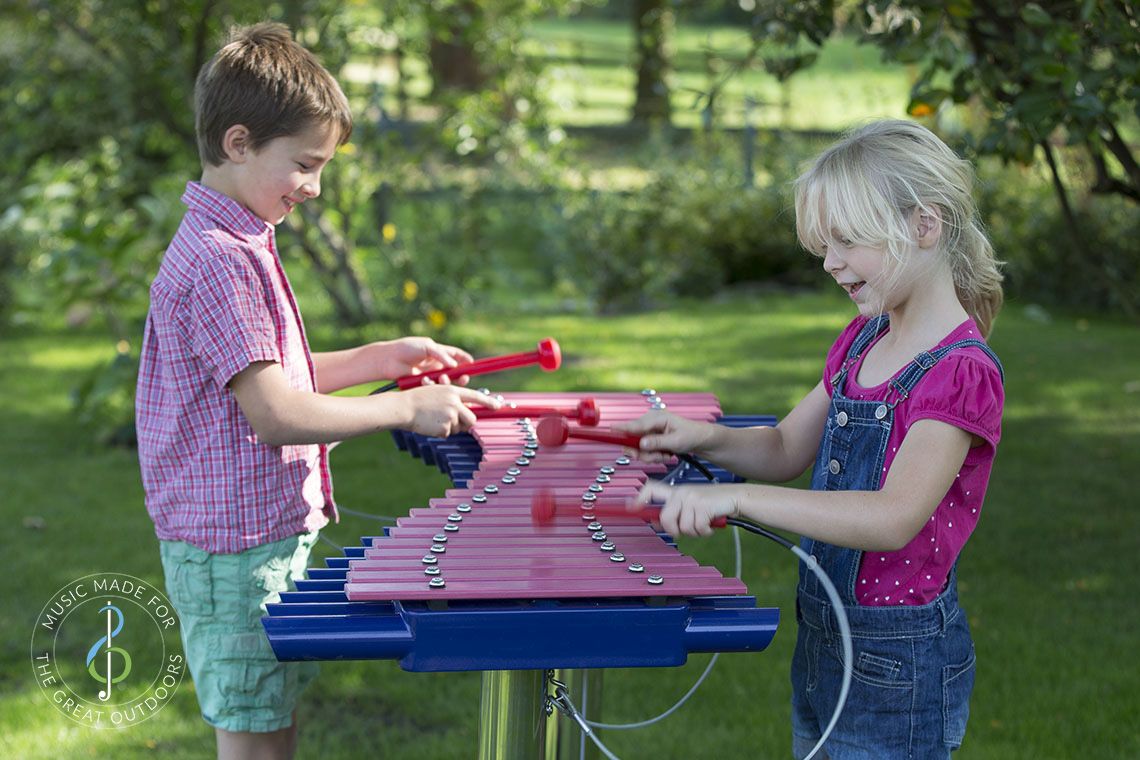Outdoor Musical Play & Children’s Mental Health Week 2020
We are almost halfway through ‘Children’s Mental Health Week 2020’: an awareness week launched by Place2Be in 2015 in an effort to ‘shine a spotlight on the importance of children and young people’s mental health’. Place2Be is a children’s mental health charity which has provided counselling and mental health support and training in almost 640 schools across the UK over the last five years.
Research has consistently demonstrated the positive impact of music and musical engagement on both mental health and child development. Likewise, the effects of exposure to green space, daylight and fresh air on mental and physical wellbeing have been proven to be similarly crucial. Access, therefore, to outdoor musical instruments is sure to maximise the benefits of both time spent outdoors and musical participation to provide an active solution for the improvement and maintenance of children’s mental health.
Outdoor musical instruments, particularly when installed in a nursery or school playground, encourage children to get outside during daylight hours, whilst using music as an outlet for creative self-expression (creativity is also demonstrated to positively affect psychological wellbeing), and providing an environment for developing social skills and inclusivity through group play.

The Curative Powers of the Outdoors
Percussion Play’s outdoor musical instruments are deliberately fashioned to withstand the elements throughout the year, and whilst the rain and cold February air may conjure up ideas centring more around the indoors, the winter months are perhaps the most crucial time to encourage outdoor play for the sake of children’s mental (and physical) health.
Whilst the days are beginning to get longer here in the UK, there is still a severe lack of natural light and vitamin D available on a daily basis as a result of shortened daylight hours, leaving children far more susceptible to deficits in serotonin, associated with decreased sun exposure. In turn, this can lead to – or at least contribute towards – certain forms of depression or depressive tendencies with seasonal pattern, in both children and adults (including Seasonal Affective Disorder). Reduced sunlight and changing seasons have also been linked to anxiety-related disorders and sleep disturbance or insomnia.
Even a brightly lit classroom produces radically worse lighting conditions than an entirely overcast, cloud-covered day. Units called ‘lux’, which measure light quality and brightness, display that whilst a cloudless day can produce more than 100,000 lux, and even a cloudy day may reach 10,000 to 40,000 lux, even the brightest artificially lit classroom is unlikely to exceed 500 lux – meaning that children who remain indoors are hugely restricted from reaping the incontestable benefits endowed by exposure to natural light.
During this wintry Mental Health Week - and beyond, it is vital to continue encouraging outdoor play – even outdoor lessons – to ensure the maximisation of exposure of children to natural light for the protection of their mental health.

Musical Play, Education and Child Wellbeing
One effective way to achieve this, whilst simultaneously promoting musical engagement – which, as we have already briefly touched on, is similarly proven to hugely benefit the emotional and psychological wellbeing of both children and adults, is to encourage the installation and use of outdoor musical instruments in school playgrounds, which can be both incorporated into school music lessons and utilised during break and lunchtimes.
Music – it is well known – is an invaluable resource when it comes to maintaining and improving children’s mental health; it sparks creativity, inspires innovation, stimulates emotional response and development.
Playing a musical instrument has long been associated with comfort, catharsis and self-expression. Outdoor musical instruments of the sort manufactured here at Percussion Play, furthermore, can be key for social development. Many of our individual instruments (and all of the ensembles) encourage collaborative play, which in turn bridges a crucial gap to allow for the development of social skills, inclusion and building relationships as well as rhythm.
In the evolving austerity-first climate of global education systems, where budget cuts as a result of government policies mean that the creative arts (such as music, drama, fine art etc.) are more at risk than ever for dissolution in our school systems, it is becoming vital that we look to ways for music to permeate school playgrounds and environments, in order to preserve the role of musical play for children.
Despite overwhelming evidence to suggest the therapeutic benefits of musical play (music therapies are becoming increasingly mainstream), funding cuts have caused the number of students studying arts subjects like music to fall to the lowest enrolment rates in over a decade, forcing community-run projects to pick up the slack in engaging children with musical play.

A Better, Healthier Future
It is more important now – perhaps – than ever before, to ensure that musical access for children extends beyond the music classroom. As the demands on child and adolescent mental health services continue to skyrocket as children in our society appear to become more and more unwell, it is crucial to look to methods of incorporating these alternative therapies (music, art etc.) into everyday child life.
We must believe in a better, healthier future for our children: one where play, movement, creativity and rhythm afford young people the opportunity to stay young and stay well.

